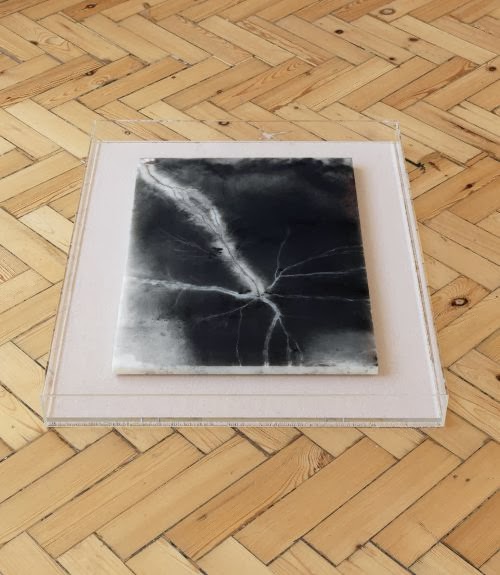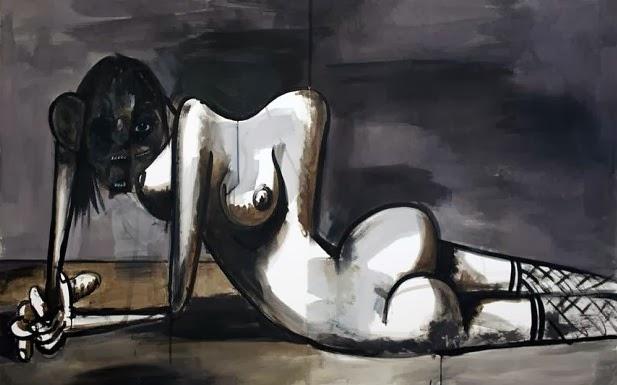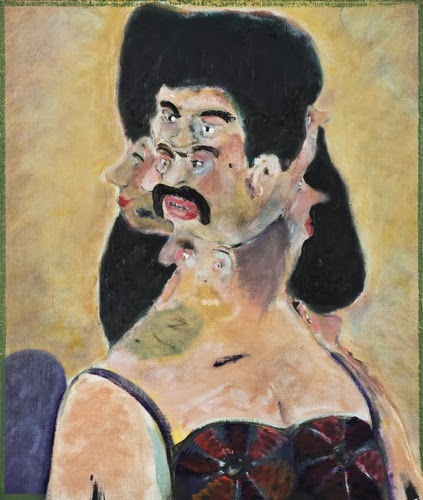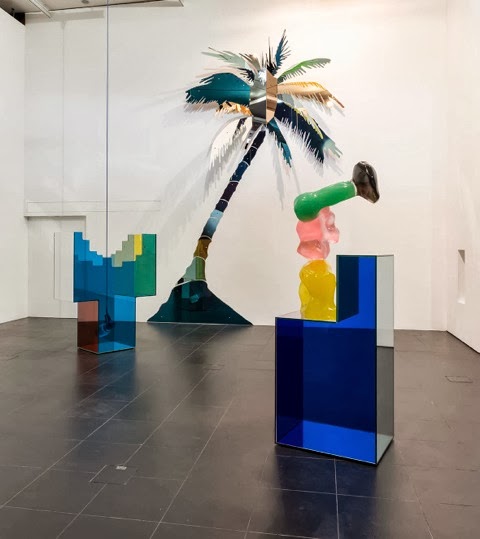Art critic Paul Carey-Kent has released his latest, rolling top ten Current Choices of must see exhibitions, currently on view in London, in March. It represents a strong mixture of established and emerging artists.
George Condo: The Discarded Human, 2013
I kind of like the idea that my header image in March is something of a no-header… George Condo: Headspace @ Simon Lee Gallery, 12 Berkeley Street and Ink Drawings (Top Photo) @ Skarstedt, 23 Old Bond Street To 22 March / 5 April: www.simonleegallery.com / www.skarstedt.com
George Condo is a master of imaginatively energetic drawing which bursts out of a defined format. As such, he’s perfectly suited to this extremely coherent two site show: big, dark watercolour figures at Skarstedt, and brightly painted character portraits at Simon Lee. Picasso, Gris, Bacon and Giacometti are heavy in a psychlogical cubist mix which ends up looking 100% Condo (he says he ‘uses every artist to become me’). My favourites are the kitschily architectural heads which make an instant impact contradicting their complexity, and a grotesquely voluptuous nude with both a displaced head and its shadowed absence.
Ryan Mosley @ Alison Jacques Gallery, 16-18 Berners St – Fitzrovia
To 15 March: www.alisonjacquesgallery.com
Surrealism tends towards a flatly factual style, but Ryan Mosely is absurd yet painterly, which has fewer precedents – maybe Magritte’s Période vache . Here it’s pretty much business as usual in his world of alternative myths: fewer pipes, true, and more birds but a stable incidence (lots) of big beards and more of a tendency to generate slippages between the world-be-real and the avowedly abstract, most obviously in a man composed of multi-coloured bananas. Plus there’s a good mix between complicated set pieces and small-scale quirkiness such as the punning morbidity of a skull on a foot being called Dead Leg and the ambiguously-sexed and multi-faced Duchess of Oils.
Licht wil raum mecht hern (Lef el rial bel), 2013 – 300 x 275 cm
Georg Baselitz: Farewell Bill @ the Gagosian Gallery, 6-24 Britannia St – Kings Cross To 29 March: www.gagosian.com
The Bill in question here is de Kooning who directly inspires the colour schemes and freedom of approach in a dozen giant self-portrait heads in which Baselitz wears a cap labelled ‘Zero’: just the name of his paint suppliers, but close to making a nothing out of ‘Hero’ – himself in the context of de Kooning, perhaps? Baselitz worked across them simultaneously on the floor of his vast studio, so the scale at such close quarters undermined his control. Consequently, the fluid markmaking often comes close to reducing all except the word ‘Zero’ to an abstraction – and even that is, of course, inverted along with the heads (with one playful exception, in which I guess being the right way up makes the logo upside down).

Daniel Lefcourt: Cast @ Campoli Presti, 223 Cambridge Heath Rd – Bethnal Green
To 22 March: www.campolipresti.com
This is the archetypal Campoli Presti show, i.e. work which explores slippages between object and representation and can tend towards a monochrome result (see Eileen Quinlan, Liz Deschenes, Scott Lyall, Olivier Mosset…). It’s interesting, though: Lefcourt has photographed studio dust and debris in macro-resolution, used computers to turn the result into a relief model the size of his pretty big paintings, filled the resultant mold with paint, let it dry, peeled it off and stuck it to canvas. This maximally complex path to a paintinig uses only one colour, but the effect varies according to its resultant depth, so images of sorts emerge; and they come in pairs with slightly different production processes applied. So what are they, objects or representations? I knew we’d be asking that…
He Xiangyu @ White Cube, Bermondsey St – Bermondsey
To 13 April: www.whitecube.com
This plus Darren Almond’s night photos and Franz Ackermann’s cathedral of cities in the 9x9x9 space make for a good trip to Bermondsey, not to mention there’s an excellent show across the street at Vitrine. The young Chinese conceptualist He Xaingyou, ranges from the one child policy (a lone egg in a gold eggbox), Tiananmen Square (a deflated leather tank), consumerism (rocks which look like coke as in coal turn out to be the residue of burnt coke as in cola) and his loneliness away from home (copper casts derived from the internalising move of feeling his mouth with his tongue, set in an a palate-pink room). My favourite work is the smallest: a pagoda which personalises a surreal pun by incorporating his own wisdom teeth.
New Order II: British Art Today @ the Saatchi Gallery, Duke of York’s HQ, King’s Road – Sloan Square
To 23 March: www.saatchigallery.com
The second chunk of Saatchi’s New Order (or should that be ‘Wen Orred’?) samples 13 artists living in London. It’s a big improvement on Part 1: Virgile Ittah’s melted antique figures, Mary Ramsey’s abstract edge manoeuvres, Dominic Beattie’s homemade retro-constructivism, Dan Rees’ plasticine satires of ab ex and Sarah Dwyer’s swirly-world all have something to be said for them, though my favourites are Martine Poppe’s mistings (more in Wandsworth below) and Tom Gidley’s interactions of Richter blur with early Fontana ceramic, part of a sub-trend for staging painting with extras (qv Kate Hawkins, George Little, Finbar Ward). Still, the best reasons to visit remain for Dana Schutz and Chantalle Joffe, downstairs in Body Language.
Martine Poppe: Analogical Change 15
Arcana @ Kristin Hjellegjerde, 533 Old York Road – Wandsworth
To 16 March: www.artecogallery.com
It’s worth a trip to Wandsworth to see this lively three woman’ show. London-based Norwegian Martine Poppe’s most recent work discovers an innovative way to handle the still life: painting in oil over polyester restorations fabric with large scale photographs beneath, she uses an expressive brush mark, but repeated to the point of unemotionality, to half-obliterate the subject as she represents it – and with the curious effect that the brushstrokes take primacy over the image from the side, but it’s the other way around from the front. Plus Gemma Nelson’s enamel candy intricacy applied to all manner of ceremonies and myths, and Amy Stephens’ harmonic plays on space, newly infected by a residency in the Sultanate of Oman.
Minke, 2103
Amy Stephens: Patterns in the Chaos @ William Benington Gallery, 20 Arlington Way – Angel
To 29 March: www.williambenington.co.uk
Wandsworth provides a taster of Amy Stephens, but her work benefits from separate space, with which it can interact with intimations of the time she spends working with architects. This fuller range of Stephens’ work includes copper tube drawings; a delicate balance of desire and control as a flocked wood rod courses tremblingly through Perspex; collages and paintings which imagine sculptural forms; a bronze cast of a birch branch (welded laboriously from eight separately-cast branchlets) and a whale’s vertebrae which she found being used as a doorstop in Iceland. Stephens says the original bone was almost as heavy as the bronze: I love the textural contrast of inner density and outer shine, and the synecdochical way the bone stands in for the tail.

Nina Canell: Near Here & Silke Otto-Knapp: Monday or Tuesday @ Camden Arts Centre
To 30 March: www.camdenartscentre.org
Nini Canell: Near Here (1 Microsecond), 2014 – photocopying toner, nylon, floor carpet, perspex, 1,000,000 volts during 1 microsecond
Camden Director Jenni Lomax has a way with the double header, here a match-up of insubstantialities delicately transformed. Silke Otto-Knapp uses black watercolours on canvas, into which she paints natural and literal stage sets by removing layers so that, in her neatly paradoxical words ‘I make a mark with a view to what it’ll look like when I wash it away’. Nina Canell explores such effects as coagulating air, shredding a sock, magnetising nails into a hanging Hokey Cokey and passing 1,000,000 volts through photocopying toner on nylon. Tuesday’s my answer to Silke, by the way: the Centre’s closed on Mondays…
Gary Webb: X7 City @ Bloomberg Space,
To 13 March: www.bloombergspace.com
Considering how bright and shiny his work is, Gary Webb operates somewhat under the radar, but this deserves to be a hit, bringing memorable movement to his signature meshing of reflection and transparency; geometric and organic; artificial and natural. Against a background of life-size mirrored palm trees, drills and sanders – their functioning elements wrapped in vibrant tape – dangle from the ceiling to writhe and whirr in coloured glass vitrines. Are these, perhaps, the inhabitants of the city X7, doomed to buzz like bees on the windows of a world which has no use for their neutered analogue persistence?
PREVIOUS CHOICES STILL ON
Harmony of the Northern Flora 1927
Paul Klee: Making Visible @ Tate Modern
To 9 March: http://art.tate.org.uk/content/Paul-Klee-Exhibition
Back in the autumn, it seemed a little unnecessary to mention these 140-odd paintings. Now perhaps, it’s worth pointing out that it’s still on. Even if Klee had produced only nature pictures, or oil transfers, or geometric abstractions, he would still be significant. In fact there are a dozen paintings here which consist of little more than squares, and their variety of mood would justify a room of their own – but that would deny another glory of this thorough retrospective: how each of the 17 rooms takes us forward through stylistic modulations in the exact, carefully numbered, order of Klee’s production.
Adam Barker-Mill: Just Noticeable Differences @ Laure Genillard, 2 Hanway Place – Tottenham Court Rd
To 8 March 2014: www.lauregenillard.com
Adam Barker-Mill’s primary set-up here has a computer programme fade up, hold and fade down the LED lamps which illumine an inner circle and outer ring of colours at differential speeds over a 15 minute cycle. The effect’s a sort of mini-Turrell, but with more chromatic range. There’s also a boxier work, through the slats in which blue light alters its intensity as you move past: a Cruz-Diez by other means? Maybe, except that Barker-Mill has come to these meditative colour modulations from a career as a Lighting Cameraman. Two paths to the waterfall…
Drawn Edinburgh Shapes
Dean Hughes @ Maria Stenfors, unit 10, 21 Wren St – KX?
To 8 March: www.mariastenfors.com
Talking of male embroiderers (away with those stereotypes!) there’s plenty of intricate sewing in Dean Hughes’ first move into the application of colour. Wooden frames are hung with shapes of calico, crazed by the creases which the dying process causes in such a sensitive material – and which remain visible even after they’ve been ironed (though actually I seem to achieve a related effect with cotton!). The effect is bunting / clothes dollies / paint samples / anthologies of abstraction with a hint of seriality and a sense of potential exchange – indeed, Hughes says he found himself swapping colours around once the works were in the gallery, though he’s not encouraging visitor revisions!

Lotte Rose Kjær Skau: United We/I Stand Etc. @ IMT, Unit 2/210 Cambridge Heath Road – Cambridge Heath
To 2 March: www.vimeo.com/77442216
Internet art hits the gallery as Danish artist Lotte Rose Kjær Skau merges Camgirl with Cindy Sherman in ten versions of herself in trance to – mostly unheard – beats. Each self-invention has a digital add-on, from subtle as hair-sparkle to blatant as lightning, so by the time you factor in what Kjær Skau is wearing, where she is, what she might be hearing, how she moves, who might be looking her and how she’s chosen to embellish her image, the play of identities gets quite complex – as does the accompanying essay, channelling Laing, which IMT have meritoriously commissioned from Morgan Qaintance.
You see my mother, she just doesn’t know how to light a lighter, 2014
Ariel Reichman: Who distinguishes light from dark @ Waterside Contemporary,
2 Clunbury St – Hoxton
To 22 March: www.waterside-contemporary.com
Tel Aviv and Berlin-based Ariel Reichman insists a on cool white minimalist space by refusing to use the walls. But the show has a dark heart: a narrow pitch-black room in the middle – on the outside of which are drawings, photographs and ‘a burnt stone’ – houses Reichman just-about operating a wind-up torch fast enough to be visible on film. Yet his mother has it tougher, struggling for five minutes to get the knack of igniting a cigarette lighter for the first time. A couple of hundred attempts see her essay such moves as the wrist-hold, the shake and the multi-flick until her thumb’s distinctly dented. Given my DIY skills I empathise. Is it just as hard to find illumination in art?
Rupert Newman: Tripping the Light Fantastic @ Cock ‘n’ Bull Gallery, 32 Rivington St – Shoreditch
To 9 March: www.cocknbullgallery.com
Three screenshots from Changing Faces
In the space below the Tramshed Restaurant (Hirst animals, Chapmans wallpaper), pop-up gallerist Aretha Campbell presents the art adventures of Rupert Newman, whose commercial day job recently included a light installation for the Brit Awards After Party. What I assumed were two films sequencing psychedelic-geometric mutations as if, say, Delaunay and Goncharova had got loose on a computer, are in fact live, mapped projections – a technique typically used for concerts or to project adverts onto buildings. That means a digital print forms the ground, and coloured light and images are projected onto its structure. Newman’s software enables him to mimic the shapes, allowing the light to create illusions by responding differently to printed and unprinted elements. Changing Faces mixes in landscapes with sound enhancing the viewer’s journey, while Impetus is more architectural and slow-moving.
Beth Collar: Some Chthonic Swamp Experience @ Tintype Project Space, 107 Essex Rd – Islington
To 8 March: www.tintypegallery.com
Here’s the artist’s hand as you may not have seen it before: not painting, but drowning in clutched despair in earth pigments on acetate wrapped around the walls. That’s an awkward enough combination to ensure a cartoonish quality to the apparently flood-prescient results of Beth Collar’s in-gallery residence. In front of all this, plaster hands are mounted on rickety tripod contraptions, part branch, part real. When I collared Beth for the meaning of those, she cited the superstition attributing power to the severed hand of a hanged man if it holds a candle made from his fat. That reminded me of Morten Viskun, the Norwegian who paints using a severed hand as a brush. Yet the chthonic title is from Camille Paglia. This show could take you anywhere…
All words: by Paul Carey-Kent Images courtesy the relevant artists + galleries + Jochen Littkemann (Baselitz)










